|
JESUIT
INSTITUTIONS
IN
THE CZECH REPUBLIC
page
1 of 2
|
|
Jesuit
College and Church of Saint Ignatius, Chomutov
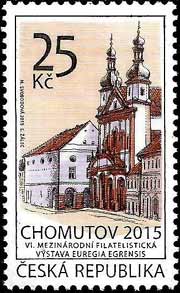
CZECH REPUBLIC, 2015, commemorating the
6th Czech-German philatelic exhibition
and featuring the Jesuit Church of St. Ignatius, Scott 3636
From 6 to 10 May 2015 the 6th Czech-German philatelic exhibition took
place in Chomutov, Czech Republic, on which occasion, the Czech Post released,
on April 15, a special stamp which depicts the Baroque Church of St. Ignatius
with its two towers, built for the Jesuits by Italian architect Carla
Lurago between 1663 and 1671. On that stamp to the left, adjoining the
east side of the church, is the building called "Špejchar"
(granary), dating from the 17th century. It was used by the Jesuits as
their first church. Boleslav Jirí Popel of Lobkovice brought the
Jesuits into the city in 1589 and a year later founded the Jesuit college.
The Church of St. Ignatius was added to the college in 1660s. When the
Order was dissolved in 1773, the college was turned into a military barracks.
It is now the Center for Librarian and Cultural Services and serves for
museum exhibitions.
The
Sanctuary of Holy Hostýn,
Moravia
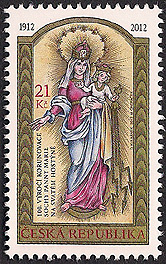
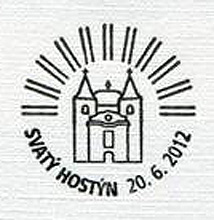
CZECH REPUBLIC, 2012, the Centenary of the Coronation
of Our Lady of Hostýn and its FDI cancel, Scott 3539
Svatý Hostýn, Holy Hostýn,
is the most frequently visited pilgrimage shrine in Moravia and after
Velehrad the most memorable one. For three centuries now thousands of
pilgrims have been converging on Hostýn mountain with its sanctuary
of Our Lady to seek and find there a refuge from their troubles and needs.
Above the main altar of the Basilica of the Assumption of Our Lady is
located a life size statue of the Virgin Mary. The Child Jesus, whom she
is holding in her embrace, is aiming bolts of lightening at the Tatars
depicted beneath the statue. These cruel marauders, who were threatening
Europe during the 13th century, invaded Moravia in 1241, murdering and
plundering. The people sought refuge in the forests and mountains to save
their lives and whatever property they could bring with them. According
to legend, those who found refuge on Hostýn were saved through
the intercession of the Virgin Mary, when the encampment of the marauders
was destroyed by fire caused by lightning. Written records concerning
Hostýn come chiefly from the Jesuit Bohuslav Balbín. In
the book, Sacri pulveres, of 1669 by George Crugerius, we read
that the people saved from the Tatar invasion erected a statue of the
Guardian Virgin Mary on Hostýn mountain out of gratitude. After
the Restoration of the Society of Jesus, the Czech bishops entrusted them
with the pastoral care of Hostýn 1887 (and in 1890 of Velehrad).
Towards the end of the 19th century the Society of Holy Hostýn
was established, and since 1895 it has worked with the Jesuits to preserve
the Christian character of Holy Hostýn for generations to come
both as an important pilgrimage place and also a cultural monument, and
to care for the administration, maintenance and repair of the buildings,
to secure funds for the further development of Holy Hostýn, and
to organizes scores of educational and cultural courses at Hostýn.
The
Church of the Immaculate Conception & St. Ignatius, Klatovy
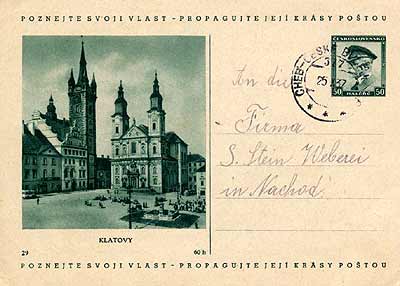
CZECHOSLOVAKIA, 1937, postal card featuring the Jesuit Church of the
Immaculate Conception and St. Ignatius at Klatovy
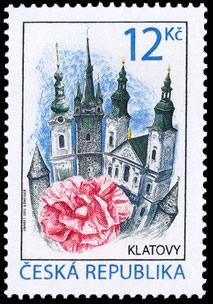
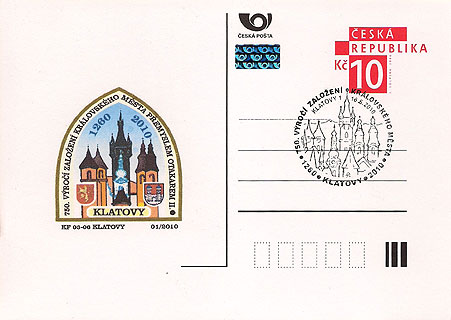
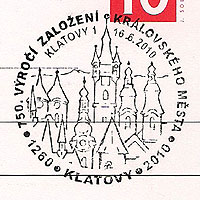
CZECH REPUBLIC, 2010, stamp (Scott 3459), postal
card, and cancel showing the Jesuit church
(the two towers to the right of the central black town hall tower)
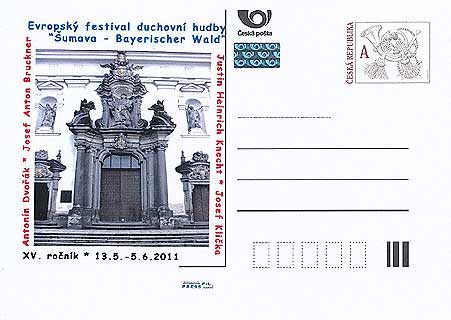
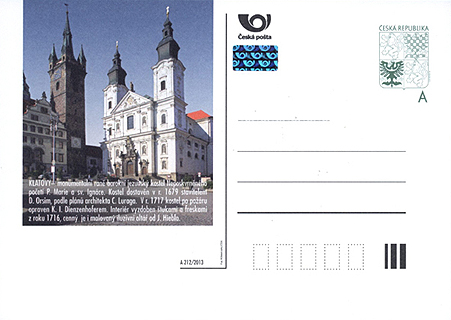
CZECH REPUBLIC, 2011, issued by Pressfil (Pre2011/20) for the European
Festival of Sacred Music this postal card features the church's main door
CZECH REPUBLIC, 2013, this postal card features the church, issue A 212/2013
from set CDV 160 B
The former Jesuit Church of Virgin Mary's Immaculate Conception and St.
Ignatius is located in the center of Klatovy in the southWestern part
of the main square and it is a prime example of Czech Baroque architecture.
The Jesuits came to Klatovy officially in 1636. They began to teach in
a temporary furnished house immediately. In 1655, the foundation stone
of the college building was laid and one year later the foundations for
their church. The first mass was celebrated in December 1675, and the
church, still not yet completed, was consecrated in 1679. The church together
with the Town Hall and Black Tower are the most distinctive dominating features
of the town. The first builder of the church was Carlo Lurago, an important
Italian architect and sculptor. The project was later taken over by Giovanni
Domenico Orsi de Ursini, another distinguished Czech-Italian architect.
The gorgeous church has a classical Jesuit ground plan of a Latin cross
with a dome above the crossing of the arms. As you enter this unique
flower of Bohemian Baroque via a richly decorated portal, you will most
certainly admire the masterful work of Kilian Ignac Dientzenhofer. The
church is located above mysterious catacombs, a former burial ground,
which still features about thirty mummified bodies resting in peace. The
catacombs received the first bodies in the early 1670s. A sophisticated
ventilation system maintains an optimum temperature for preserving them.
The visitors can see the bodies in coffins with glass lids! The Jesuit
College was aimed at raising the standard of education of the local people.
After the dissolution of the Jesuit Order the building was turned into
a barracks and a school of brewing. From 1990 it has been used as a shopping
center and as the seat of the town library. The Jesuit Baroque pharmacy, another major sight on the main square, with the original 1773 equipment,
is protected as one of the UNESCO scientific and technical monuments.
St.
Barbara Church & the College, Kutna Hora
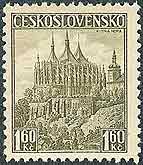
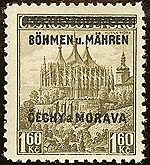
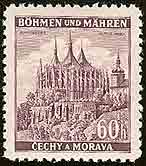
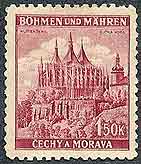
CZECHOSLOVAKIA 1937, Scott 240; SLOVAKIA, 1939 overprint (not shown), Scott 15; and BOHEMIA AND MORAVIA, 1939,
1939 and 1941, Scott 13, 29, 53
The overprinted stamp shown is an error: 8ÖHMEN not BÖHMEN.
The
history of the Jesuits in the Czech Republic began in 1556, the year
Ignatius died, when just months before his death he sent 12 Jesuits to
Prague to a newly prepared home by St. Clement Church. The Bohemian
Gothic Church of St. Barbara at Kutna Hora was granted to the Jesuits
in 1626. At the right of the picture can be seen the corner tower of the
Jesuit college
attached to this church.
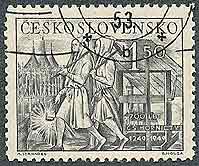
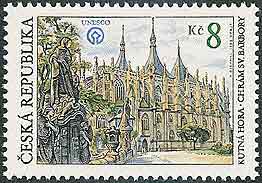
CZECHOSLOVAKIA, 1949, the 7th centenary of the Czechoslovak mining industry,
Scott 394
CZECH REPUBLIC, 2000, Cultural Heritage of Humanity, Scott 3056
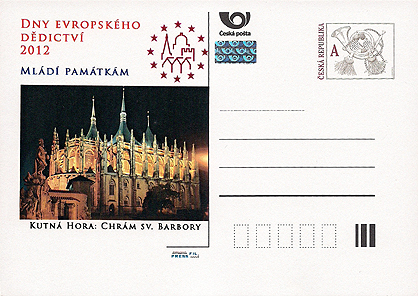
CZECH REPUBLIC, 2012, postal card celebrating European Heritage Day
issued by Pressfil (Pre2012/51)
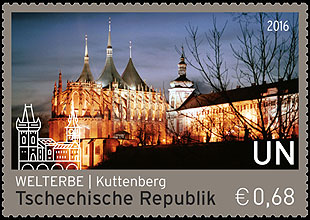
UNITED NATIONS, 2016, honoring World Heritage sites, Scott 1144c;
(Geneva Offices) Scott 627c; (Vienna Offices) Scott 592, 594c.
The
Jesuit University and Library, Olomouc
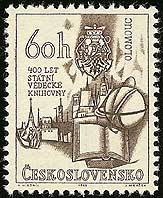
CZECHOSLOVAKIA, 1966, the 4th centenary
of the Research Library in Olomouc,
Scott 1412
In 1566 a Jesuit academy was founded
in Olomouc and with it a library. In 1573 the academy was raised to the
status of a university, the second university in the Czech Lands after Charles University in Prague. Jesuits ran the university
until the Suppression 200 years later. After the Suppression, in 1775,
the university and its library were taken over by the state. It began
to be shut down in 1848 to punish the students for their role in the revolution
and by 1860 had ceased to operate. The Faculty of Theology, however, together
with the University Library, continued in existence. In 1946 the Czechoslovak
National Assembly voted to reestablish the university and gave it the
name Palacký University. The library attached to the original academy
and the university has become a public library, the second oldest and
the third largest library of its kind in the Czech Republic. The above
stamp in 1966 celebrated its 400th anniversary.
Bethlehem
Chapel, Prague
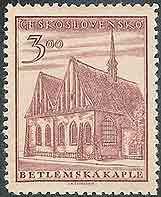
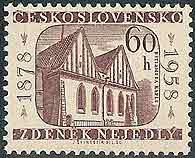
1952, the 550th anniversary of Hus' installation as pastor, 3.00 koruna value,
Scott 535
1958, the 80th anniversary of the birth of Zdenek Nejedly, restorer of the
chapel, Scott 845
The Bethlehem Chapel in Prague was founded in 1391 for sermons in the
Czech language. Jan Hus preached there from 1402 to 1412, and it became
symbolic of the Hussite movement in Bohemia. It reverted to Catholicism
and was given to the Society of Jesus in 1622. The
chapel was demolished in 1786, but rebuilt again after 64 years.
The
Church of Our Lady before Tyn, Prague
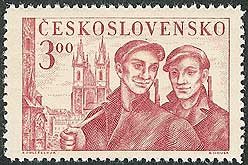
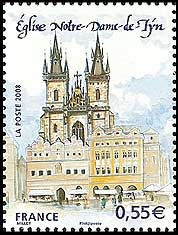
CZECHOSLOVAKIA, 1950, Scott 408
FRANCE, 2008 from a souvenir sheet
honoring Prague, Scott 3535
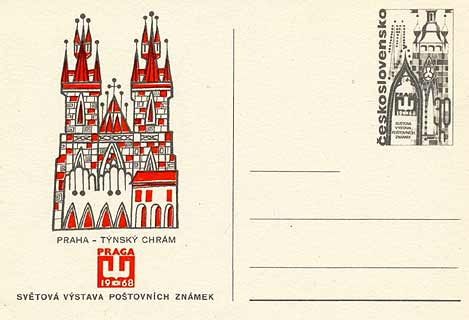
CZECHOSLOVAKIA, 1968 postal card of the Church of Our Lady before
Tyn honoring the Prague 1968 World Exhibition of Postage Stamps
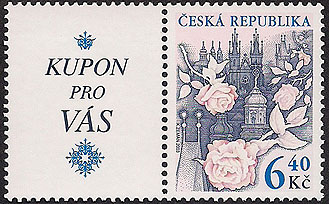
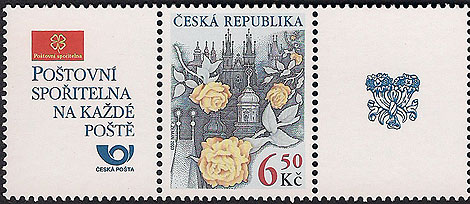
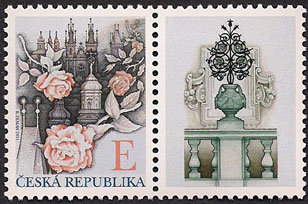
CZECH REPUBLIC, 2003 with face values of 6.40 Kc (Scott 3196) and 6.50
Kc (Scott 3222)
2011, the stamp is now somewhat redesigned and the face value replaced with
a letter.
The Church of Our Lady before Týn may be seen in the background, Scott 3517
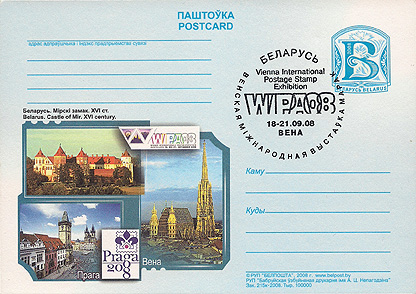
BELARUS, 2008, a postal card shows (lower left) the Church of Our
Lady before Tyn in the distance.
The Church of Our Lady before Tyn, an imposing Gothic church with a Baroque
interior, dominates one side of the Old Town Square in Prague. Around
1385, this one time hospital church was converted into the main cathedral
of the Old Town. Between the beginning of 15th century and 1620 this was
a stronghold of the Hussites. Its church was taken over by the Jesuits
in 1623, who symbolically made the church Catholic and their own by recasting
its bell and replacing the Hussite chalice between the towers with a ten-foot
figure of Mary. The church contains the grave of the famous Danish astronomer
Tycho de Brahe. Tyn means a foundational town protected by a fence or
a fortified area where merchants could sell their wares safely, and such
an area was once part of old town, though nothing now remains of it.
The
College of St. Clement, Prague

1967, Prague the Mother of Cities, showing St. Clement College (right)
as well as St. Nicholas Church (left), Scott 1446

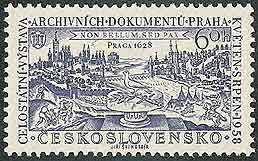
1955, Scott C44
1958, Scott 855
The first three items show Charles Bridge crossing the Danube in the
center of the picture. The dome and clock tower of St. Nicholas Church,
soon to be mentioned, can be recognized to the west (left) of the bridge,
although it is not present in the 1628 depiction (above right) which antedates
its construction. Immediately to the east (right) of the bridge on the
Old Town side of the Vltava River (in German, the Moldau) may be seen
the towers that belong to the Clementinum or College
of St. Clement, founded by St. Peter Canisius in 1556. It is the largest complex of historical buildings in the city.
Six years later the college received authority to confer degrees in theology
and philosophy and became Ferdinand University, in honor of its protector,
the emperor. The Caroline or Charles University was joined to this Jesuit
university beginning in 1622. After the Jesuits were suppressed in 1773,
the Clementinum became Prague
University and the home of the Czech National Library. The buildings
now house the St. Salvator Church (the Roman Catholic Academic Parish
of Prague) with
the seal of the Society at the top of its facade, and St. Clement
Cathedral both part of the Clementinum, in which the National Library
of the Czech Republic is now housed. St. Salvator Church was built by
the Jesuits between 1578 and 1601.
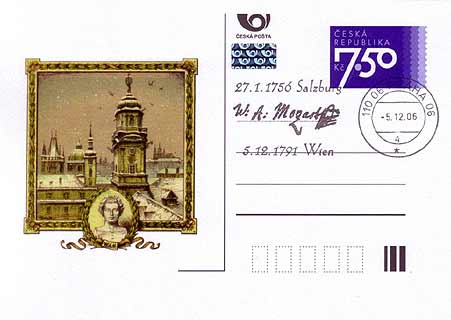
CZECH REPUBLIC, 2006 a view of the Clementinum in this postal card issued
by Pressfil (Pre2006/09cp)



CZECH REPUBLIC, 2003 with face values of 6.40 Kc (Scott 3196) and 6.50
Kc (Scott 3222)
2011, the stamp is now somewhat redesigned and the face value replaced with
a letter.
The graphic composition is centered around the astronomical tower of the Clementinum
with the statue of Atlantis.
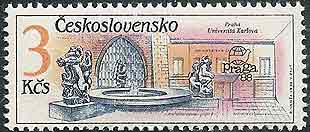
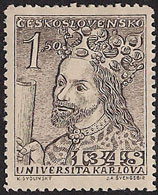
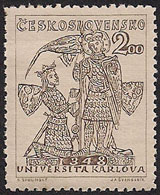
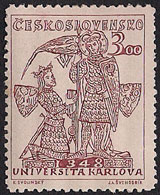
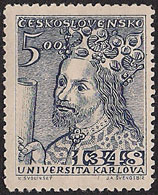
CZECHOSLOVAKIA, 1988, Charles University, Scott 2707 which also appears on a souvenir
sheet, Scott 2708a
CZECHOSLOVAKIA, 1948, four stamps to honor the 600th anniversary of Charles University,
Scott 346-9
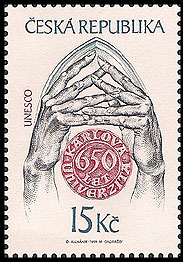
CZECH REPUBLIC, 1998, from a souvenir sheet to commemorate Prague's 650th anniversary, at stamp with
the seal of Charles University, Scott 3040
The
Holy Mountain near Pribram
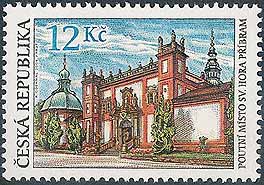
CZECH REPUBLIC, 2004, Scott 3243
Svatá Hora (Holy Mountain) overlooks Príbram about 35 miles
southwest of Prague. The first chapel of Our Lady may have been built
here in 1260, a somewhat larger sanctuary had been built by the 16th century.
Originally watched over by recluses, Svatá Hora was entrusted to
the Jesuits in 1647 who maintained it for the next 126 years until their
Suppression. They built the present sanctuary in 1673 consecrated in honor
of the Assumption of Our Lady. The Holy Mountain is among the most famous
places of pilgrimage in the Czech Republic.
The
Sanctuary of the Assumption, Velehrad
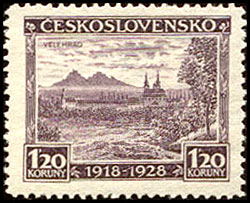
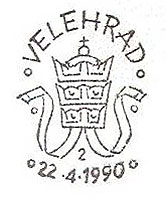
CZECHOSLOVAKIA, 1928, 10th Jubilee Anniversary of Czechoslovakia, Scott 147
CZECH REPUBLIC, 1990, a special cancel to mark the visit of Pope John Paul II to the Velehrad
Sanctuary on 22 April 1990
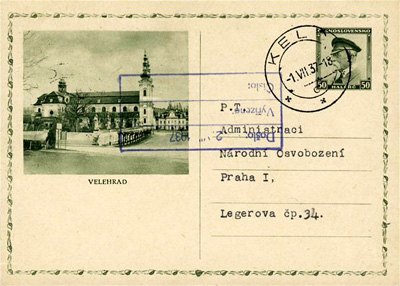
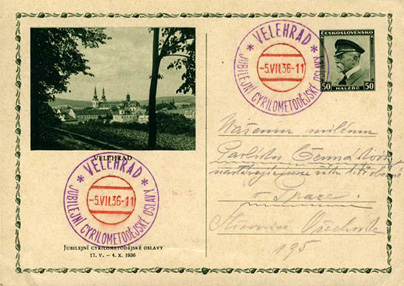
CZECHOSLOVAKIA, 1936, to the left, the last of a set of 58 scenic
cards (CDV 61/58)
both cards were issued (CDV62/1-2) with the inscription (bottom left):
The Millennial Anniversary of Saints Cyril and Methodius May 17-October
4, 1936
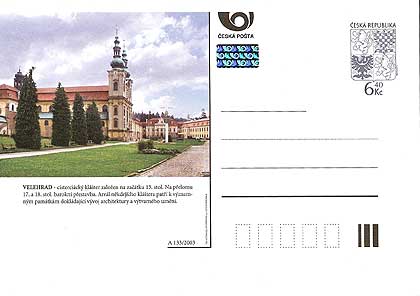
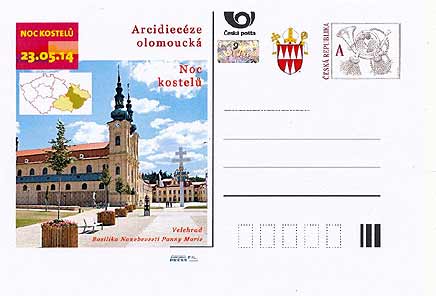
CZECH REPUBLIC, 2003, (#A133) and 2014 (PressFil 2014/15) postal
cards
featuring the Velehrad Sanctuary
The Sanctuary of the Assumption at Velehrad, founded by the Cistercians
in 1205, was entrusted to the Jesuits in 1890 as a novitiate. An adjoining
building, until 1950, housed the Pontifical Institute of Saints Cyril
and Methodius to prepare missionaries for the Slavic world. (Velehrad
is the site of Methodius's tomb) On April 13, 1950 the Jesuits and other
religious communities not yet expelled were evicted, collected into former
monasteries, and subjected to forced labor. The Sanctuary was returned
to the Jesuits in 1990.
NEXT











































